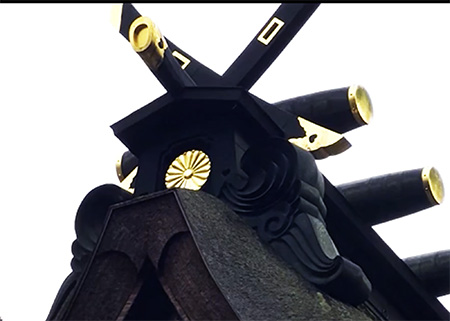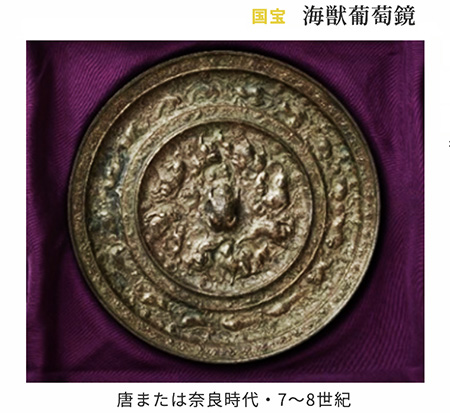


明治以前まで全国の神社の中で「神宮」という名称を託されていたのは、伊勢と香取・鹿島の3社のみ。
神社建築の場合は祀られる神さまが鎮座される建築が「本殿」であり、それに対して参詣する場が「拝殿」ということになる。一般的な神社建築ではこのふたつは一体的だと思う。わたしが毎日のように参拝する北海道神宮でも拝殿の奥に本殿が連続している。この香取神宮でも同様のスタイルで、拝殿の奥に本殿があって建築的には「繋がって」連棟形式で建てられている。鹿島神宮では本殿は令和の建て替え工事中で仮囲いされていたけれど、建築スタイルとしてはこの香取と同様に連棟形式が採用されていた。
デザイン傾向として、どちらも建築時期である江戸期の独特に進化した装飾形式が取られている。鹿皮のような色をした桧皮葺の屋根に黒塗り壁面が特徴。
一方、伊勢神宮では本殿は完全分離して外宮では拝殿という建築はなく、簡素な本殿建築が敷石平面の上に建っているだけでそれを仰ぎながら遙拝する形式。つくりが簡素なだけに式年遷宮という建て替えが歴史年代、一時期の衰退はあったけれど、ほぼ継続されてきた。
勅祭社らしく香取神宮本殿では屋根の飾りとして金細工で菊の紋章があしらわれ、その下の破風飾りにも金細工が施されて黒い本体着色と対比的で目を奪う装飾性を感じさせる。武神ということでもっと武骨なデザインがと思うけれど「目を奪う」という方向に向かっているように感じられる。オシャレに目覚めた武神か。
江戸期の日本社会というのは建前上は武断政治的だけれど、ながく平和が続いたことで武神というもののイメージもそのように変容していったものだろうか。香取神宮の周辺環境もまた変貌している。利根川東遷という大土木事業が成功して「香取の海」が縮小して利根川河川に変貌したのと対応しているとも感じる。

こちらは香取神宮の神宝・国宝海獣葡萄鏡。香取神宮の創建は神武18年とされてそれは確認しようもないが,
この神宝は正倉院にも同様の宝物が全5点あるという。そのなかで正倉院南倉9号収蔵品と同型とのこと。正倉院の創建は西暦756年だから、少なくともその頃にまで香取神宮の来歴は遡れることになる。
「鏡径29.7㎝。界圏は刳り込み形。鈕は伏獣形で鬣と背骨を表現し、口に小鹿を咥える。内区の獣には有角狻猊や獅子が表され、その周囲に小獣13匹が表され、それぞれの様相も様々である。帯圏上に外区の葡萄文が伸びて葡萄紋と柘榴瑞果紋が表され、その間に小禽・昆虫が表現される。外区は8禽8獣が右旋回で表され外縁帯は雲花紋とパルメット紋が混合した唐草文。鏡形が大きくひとつの完成形ともいえる。」
関東を治める神格としてこうした神宝がその格式を表現。ただこの鏡を見てオシャレに目覚めたか。
English version⬇
Katori Jingu Shrine 5: Exploration of Three Shrines in Eastern Japan – 19
The same objects as the Shosoin treasures are the sacred treasures. The Shosoin treasures are the same as the Shosoin treasures, cutting-edge artifacts imported through trade with the Tang Dynasty. The Takejin also cared about the appearance of these treasures (laugh)…
Before the Meiji era, only three Shinto shrines in Japan, Ise, Katori, and Kashima, were entrusted with the name “Jingu” (Shrine).
In the case of shrine architecture, the “hon-den” is the building where the deities are enshrined, and the “haiden” is the place of worship where visitors pay homage. In general shrine architecture, these two are considered to be one and the same. At the Hokkaido Jingu Shrine, which I visit every day, the main hall is located behind the worship hall. The Katori Jingu Shrine has the same style, with the main hall behind the worship hall, and the two are architecturally “connected” and built in a series of buildings. At Kashima Jingu, the main hall was temporarily enclosed during the reconstruction of 2021, but it was built in the same style as this Katori shrine, in a series of linked buildings.
The design trend in both buildings is the uniquely evolved decorative style of the Edo period (1603-1868) when they were built. The roof is cypress bark thatched with a color similar to deer skin, and the walls are painted black.
On the other hand, in Ise Jingu, the main shrine is completely separated from the outer shrine, and there is no worship hall in the outer shrine, but only a simple main shrine built on a paving stone level, which is worshipped while looking up to it. Because of the simplicity of the structure, the shrine has been reconstructed in the form of shikinen sengu (ceremonial relocation of the shrine) for most of its history, although there was a decline for a period of time.
As is typical of an imperial shrine, the main hall of Katori Jingu Shrine has a gold-work chrysanthemum crest as a roof decoration, and the gable below it is also decorated with gold work, which contrasts with the black coloring of the main body, creating an eye-catching decorative effect. The gold work on the gable below the chrysanthemum crest is also gold-plated, contrasting with the black coloring of the main body, and creating a sense of eye-catching ornamentation. Is this a god of war who has awakened to fashion?
Japanese society during the Edo period was, by its very nature, a military-dominated society, but the image of the warrior gods may have changed as peace continued for a long period of time. The environment surrounding the Katori Jingu Shrine has also changed. I feel that this corresponds to the success of the great engineering project of the eastward shift of the Tone River, which caused the “Katori Sea” to shrink and transform into the Tone River.
This is the Katori Jingu Shrine’s sacred treasure, the National Treasure Kaiju Budo Kagami (mirror of sea beasts and grapes). The Katori Jingu Shrine was founded in the 18th year of the Jinmu period, although there is no way to confirm this.
This is the same treasure as five other treasures in the Shosoin Repository. Among them, this treasure is said to be the same type as the one housed in Shosoin’s Nanzang No. 9. The Shosoin was built in 756 A.D., which means that the history of Katori Jingu can be traced back at least to that time.
The mirror is 29.7 cm in diameter. The mirror is 29.7 cm in diameter, with a gouged-in outer circle. The knob is in the shape of a beast with a mane and backbone, and a fawn in its mouth. The inner category of beasts includes an antlered eminence and a lion, surrounded by 13 smaller beasts, each of which has a different aspect. The grapevine pattern on the outer section extends above the band and is surrounded by a grape and boxwood pattern, with small birds and insects between the grape and boxwood patterns. The outer band has an arabesque design with a mixture of cloud and flower patterns and palmetto patterns. The large mirror shape can be said to be one of the most complete forms.
As the deity that ruled the Kanto region, these treasures expressed his prestige. But did this mirror awaken your sense of fashion?
Posted on 8月 24th, 2023 by 三木 奎吾
Filed under: 日本社会・文化研究







コメントを投稿
「※誹謗中傷や、悪意のある書き込み、営利目的などのコメントを防ぐために、投稿された全てのコメントは一時的に保留されますのでご了承ください。」
You must be logged in to post a comment.